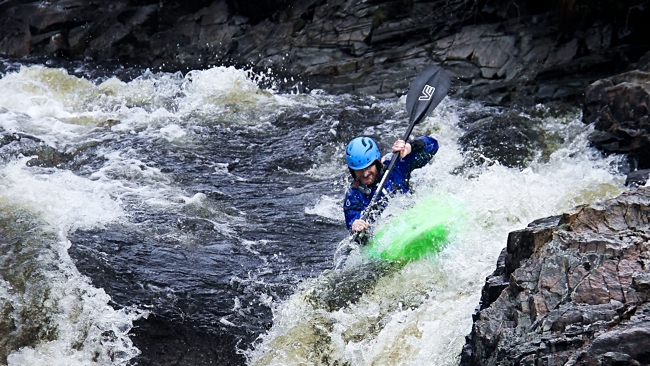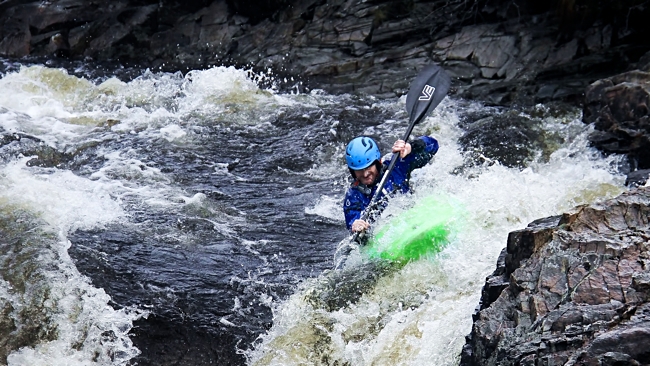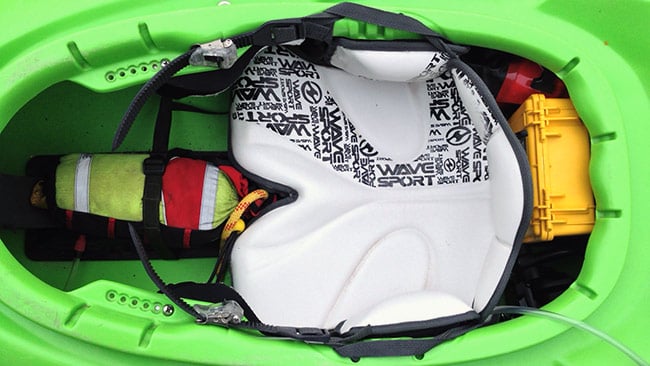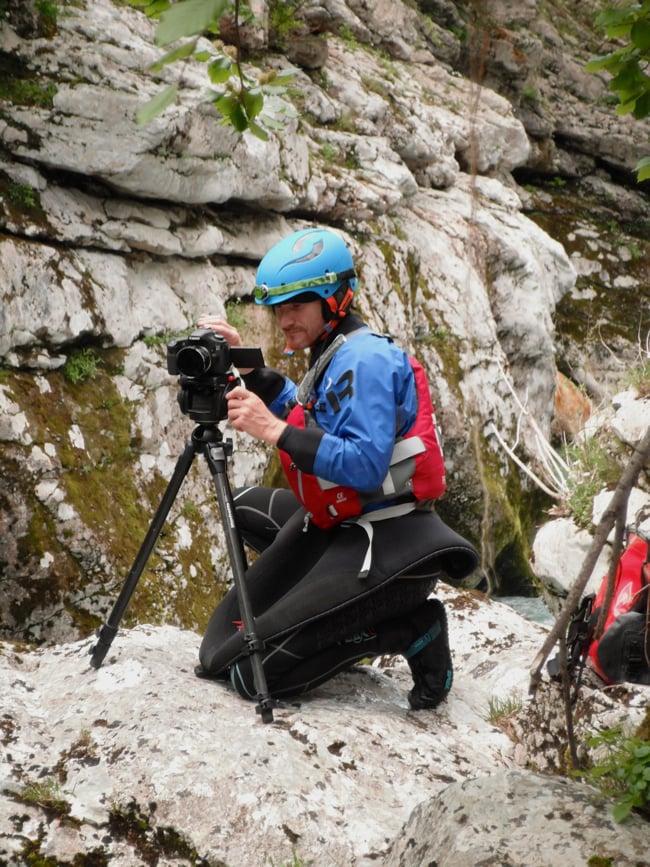
 White water
White water
New types of affordable and lightweight camera mean that there are new types of film making. And the film makers are challenging the skills of "traditional" professionals. Simon Wyndham takes the sport of Kayaking as an example
As a whitewater kayaker I spend a lot of time thinking about how to film my sport. Long have I wanted to make a documentary on the subject, but haven't quite come up with an angle that I am happy with yet. Many guys will just get on and film their experiences come what may, regardless of whether there is anything interesting to say, but my professionalism is my Achilles heel in this regard.
There is a lot of programming these days that gets made when perhaps it really shouldn’t, or at least it isn’t ready to be.
Meaningless montage
There, I've said it. I don't want to make a meaningless montage of shots. Yes, I know many camera gurus have made a career out of doing just this, and some people find such videos awe inspiring for some reason, but I won't join their ranks. If I make a film about my sport it will have a purpose, an engaging documentary that I would hope also holds the interest of those who have maybe never even paddled before.
I was recently asked to shoot a promo for a whitewater kayaking holiday/coaching provider in Slovenia. It was a tricky job given the limited resources available, but the work called upon my ability to be able to take a boat loaded with camera gear into the gorges that are encountered on such a trip.

I was thankful that I was using a DSLR. I can hear the sniggers now, but you can trust me that a camera any heavier would be more effort than the pain would be worth in such circumstances. My hat goes off to those who regularly take Sony FS700's, or even Red cameras on such trips. A kayak gets weighed down very easily and the responsiveness of the boat becomes very sluggish, as well as much more difficult to roll back up in the event of a capsize. It is a question of safety and skill level as much as it is about boat performance, and I know my limits.
Added to this I was sometimes required to go on ahead of the group along rapids I had not seen before so that I could get shots of the clients paddling down. Yet I had it pretty easy. Whilst some of the water there was pretty pushy, especially with a laden boat, my class 3-4 rapids were nothing compared with what a lot of the world class guys are doing on often extremely life threatening water.
Those guys are now often taking Sony FS700's and quadcopter drones into some of the most inaccessible places on earth. Gear that weighs far more than anything that I took. Through the canyons of Chile, Peru, Norway, Iceland, British Columbia, Vietnam, China, and Nepal, to name but a few, places and environments that need specific skills to reach, often only accessible to whitewater paddlers. A separate bank side support team isn’t really a viable option in most cases.
Many of these videos are produced by amateurs, and only a few years ago such things were very poorly produced using Hi-8 and whatever else was available. The boating skills and the beauty of the environments were undoubtable, but the production values of the videos themselves often left a lot to be desired. Typical Extreme Sports Channel fodder with endless montages of carnage set to 90's heavy metal music.
Self taught skills
Times have changed and some of the people who are currently filming this sport are now sometimes called upon to help with shooting high quality productions for National Geographic and other major broadcasters. Their self taught skills at obtaining cinematic shots in remote places has value. They are mostly all self taught amateurs, and originally had virtually no knowledge of "broadcast standards" or "the right way to do things".
In terms of the guys who produce regularly for the web many of them don't make any money from what they do. They have a passion, whitewater kayaking, and they follow it, filming it as they go. Similar things have happened with mountain biking and virtually all other adventure sports too. Some sports developed faster than others, particularly in the skiing community, helped in no small way by the fact that white powder has always had money associated with it!
The adventure sports filmmaker grew up. Now I see many people giving themselves this title, as well they might. It describes what they do well, but are they professional filmmakers? I believe that there is a new breed of filmmaker. Many of these current productions may have been made by people who are not full time video producers, but they do often have a commercial purpose.
When it comes to adventure sport documentary Warren Miller lead the way since the 60’s with ski documentaries, always shooting on film to a high standard. He even produced some pretty cool whitewater kayaking segments as a distraction too. Miller made money from his work, something that not many others have managed to do in this niche segment of film making. However Miller was an exception.
In more recent times more cash strapped adventure sports filmmakers generally shot with whatever gear they could get their hands on. Hi-8 etc gradually migrated to GoPro's, and has now advanced so far that gyro stabilised drones are being used, along with sliders, jibs, Red cameras, you name it. There is now very little separation between what determined expert amateurs can do and what professionals can do. Right down to cinematic composition, sound, and editing.

"...a production of passion"
It got me thinking about what I can possibly offer over these guys in terms of documenting my chosen pastime and what separates me as a professional video producer. If I am brutally honest I have to say not much! I don't have the boating skills to get to those places. Certainly I can bring structure and an angle to some projects that would give them more depth, but on the whole the reality is that there is no money in it. It would have to be a production of passion.
Therein lies one of the biggest hurdles in terms of professional involvement in adventure sports. The activities themselves often have spectacular cinematic value, yet there is precious little money there to produce anything. Certainly in the UK.
Often the only way such sports get documented is because of enthusiastic amateur video producers. The kayak industry has no real money to speak of to pay full time professionals to document adventures, and so many of the manufacturers have taken to learning how to produce video themselves or relying on the skills of their sponsored paddlers. They don’t really have much of a choice.
Sometimes this works really well. The Jackson kayak company for example now sponsors Steve Fisher, a South African paddler who has made some stunning feature length documentaries about his adventures for his other sponsor, Red Bull. By his own admission, while you would expect Red Bull to throw money at such projects, at first the complete opposite was true and it took some work to persuade them of the value of such video. These days of course they can see the value in producing cool sports videos, from Danny MacAskill through to Ken Block, and now employ video professionals to produce them, but Red Bull are the exception to the rule.
Most kayaking companies are often part of something bigger than simply manufacturing boats. One of the most successful companies makes much of its money from moulding plastic for toy manufacturers, not from the kayaks. Selling niche small plastic boats is simply not a way to become rich! In the world of white water kayaking things are still very much connected to the grass roots.
The new generation of film and video makers who are part of the sport are literally brought up with the language of television, but at the same time they have a disregard for the so called standard way of doing things. It is all about getting the shot, and they will often go to great lengths in achieving that.
Being professional is being consistent
Of course this mentality can sometimes result in something truly dreadful as much as it can result in greatness. Part of being professional is being consistent of course, but these guys are learning and they are now producing some very well made videos on behalf of their sponsors.
As professionals if we wanted to charge a company to make a sports promo video in a remote part of the world, possibly taking weeks to do so, transporting in cable cams, Red cameras, sliders, jibs etc the price we would charge would far outweigh the commercial advantage of having the video produced in the first place.
And so it is that the free form adventure sports filmmaker is here to stay.
Us cobweb covered professionals can learn a lot from this new generation of filmmaker. On occasion I have seen an adventure sports segment on television that has been produced by traditionally trained people. The result is often akin to watching your parents dance at a wedding. Watching people without a clue trying to get with the cool gang is often a painfully cringeworthy experience.
Adventure sports video producers have their own visual language that has evolved along with the filmmakers themselves. Just as teenagers of each generation have their own language, so adventure and extreme sports producers have evolved from era to era, each bringing their own style. While the new filmmakers are using high quality cinema as their influence, many traditional producers who want to produce a sports action segment for television are often still using videos produced in the 90's as their reference point!
It is also a fact that the way that people view a sport on the outside is often completely at odds with the way actual participants in that sport see what they do. So often the best perspectives on sports come from within rather than from an outside professional who may not understand what they are filming.
To finish, here are some examples of some videos produced by people who started by filming their kayaking adventures as basic home video, but decided to pursue things more seriously. I have yet to see any traditional professional video producer portray the sport in such a way.
Skip Armstrong started producing videos such as his Seasons series, shot with a DSLR, which went on to win awards at various adventure film making film festivals.
He later teamed up with Anson Fogel, another self trained adventure filmmaker, to produce "Of Souls And Water". A stand out piece from the series was the episode entitled "The Shapeshifter".
Finally, Kelsey Thompson’s “Balance” series is also very nicely produced.
A new breed of film maker
It cannot be stressed enough how difficult this sport is to film, so the difficulty in obtaining shots of this quality cannot be overstated. Not least because the filmmakers concerned have only been producing videos for a relatively short amount of time.
Thus we now have a new breed of film maker. One who aspires to professional production values and whose videos serve a commercial purpose, but they are not really part of the video making world as we know it. They aren't generally paid for their work, but they produce it out of passion for what they do as part of a bigger picture.
Tags: Production



Comments